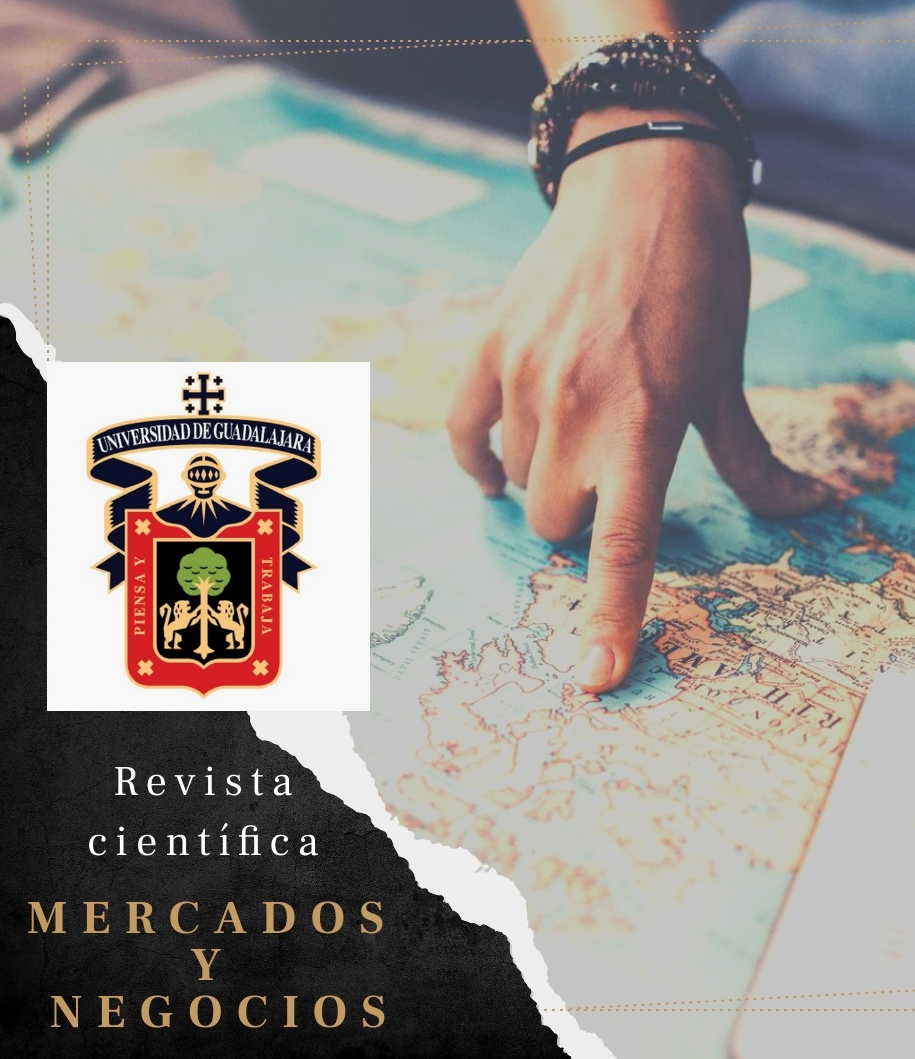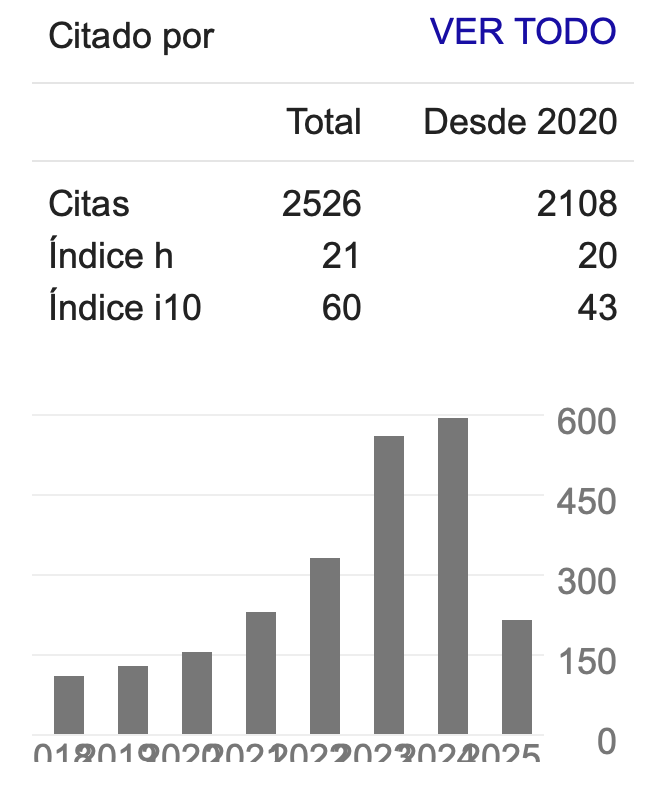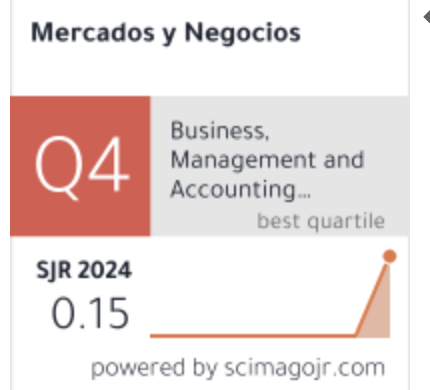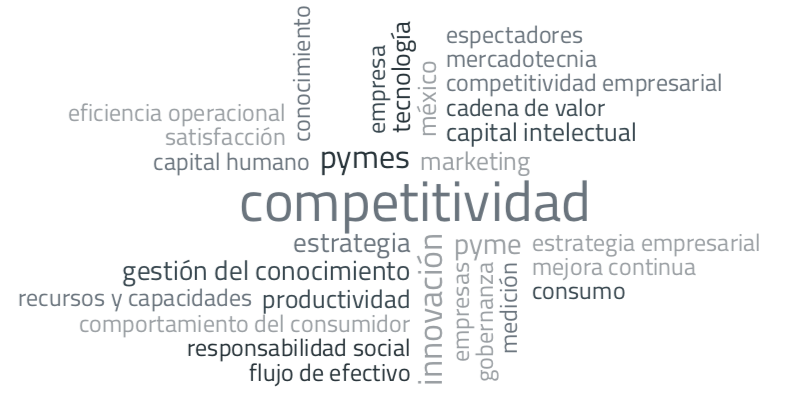Resilience and Social Inclusion: A Critical Reflection on Internal Marketing
DOI:
https://doi.org/10.32870/myn.vi43.7630Palabras clave:
Objetivos del desarrollo sostenible, Marketing interno, resiliencia, inclusión socialResumen
The aim of the paper is to identify the dimensions of the Internal Marketing that contributes to business resilience and social inclusion. Marketing is approached as a tool for social transformation. The documentary and data analysis focused on the relevant theoretical and practical models proposed in the last decades. It concludes with the proposal of four dimensions of internal marketing that stimulate business resilience and social inclusion wich are: 1) the attraction and development of talent through the competitiveness of the workplace; 2) organizational change; 3) leadership development and empowerment; and 4) communication for the exchange of knowledge and motivation.Citas
Ahmed, P. K., Rafiq, M., & Saad, N. M. (2003). Internal marketing and the mediating role of organizational competencies. European Journal of Marketing. 37 (9), 1221-1241.
Argyris, C. (1993). Knowledge for action: A guide to overcoming barriers to organizational change. San Francisco: Jossey-Bass.
Bak, A. B., Vogt, L., George, W. R., Greentree, I. R. (1995). Management by team. an innovative tool for running a service organization through internal marketing. Logistics Information Management, 8(4), 12-18.
Bakker, A. B. (2010). Engagement and "job crafting": Engaged employees create their own great place to work. In S. L. Albrecht (Ed.), New horizons in management. Handbook of employee engagement: Perspectives, issues, research and practice (p. 229–244). Edward Elgar Publishing. https://doi.org/10.4337/9781849806374.00027
Bansal, H. S.; Mendelson, M. B.; Sharma, B. (2001). The impact of internal marketing activities on external marketing outcomes. Journal of Quality Management, 6, 61-76.
Barney, J. B., & Wright, P. M. (1998). On becoming a strategic partner: The role of human resources in gaining competitive advantage. Human Resource Management, 37(1), 31-46.
Barth, M., & de Negri, A. (2015). Endomarketing: o desafío de fidelizar o cliente interno. Temática, 8(1).
Berry, L. L., Hensel, J. S., Burke, M.C. (1976). Improving retailer capability for effective consumerism response. Journal of Retailing, 52(3), 3-14.
Berry, L.L. (1981). The employee as customers, Journal of Retail Banking, 3, 25-8.
Berry, L.L. and Parasuraman, A. (1991). Marketing for Services: Competing through Quality, Nueva York: The Free Press.
Bohnenberger (2005). Endomarketing: la actuación conjunta entre recursos humanos y marketing en busca del compromiso organizacional, Tesis Doctoral, Brasil: Universidad de las Islas Baleares.
Borderías, C., & Martini, M. (2020). En las fronteras de la precariedad. Trabajo femenino y estrategias de subsistencia (XVIII-XXI). Historia Social, (96), 63-78.
Cahill, J. (1995). The managerial implications of the learning organization: a new tool for internal marketing. Journal of Services Marketing, 9 (4), pp. 43-51. https://doi.org/10.1108/08876049510094513
Cahill, J. (2017). Making a Difference in Marketing: The Foundation of Competitive Advantage. Londres: Routledge.
Cali, E. G., Barros, D., & Valle, A. (2018). Endomarketing desde el paradigma de la sostenibilidad organizacional. Desarrollo Gerencial, 10(2), 65-82.
Caruana, A., & Calleya, P. (1998). The effect of internal marketing on organisational commitment among retail bank managers. International Journal of Bank Marketing, 16(3), 108-116. https://doi.org/10.1108/02652329810213510
Cequea, M. M., Monroy, C. R., & Bottini, M. A. N. (2011). La productividad desde una perspectiva humana: Dimensiones y factores. Intangible capital, 7(2), 549-584.
Chew, L. K. (2004). Some Corporate eLearning Case Studies in Singapore. International Journal of The Computer, the Internet and Management, 12(2), 64-71.
Climent, V. (2015). La nueva pobreza en el mercado de trabajo. Intangible Capital, 11(2), 270-283.
Collins, B., & Payne, A. (1991). Internal marketing: a new perspective for HRM. European Management Journal, 9(3), 261-270.
Crosby A. (2002). A Good Try Organizing World History Environmentally. History and Theory, 41(2), 218-224
Dabirian, A., Kietzmann, J., & Diba, H. (2017). A great place to work!? Understanding crowdsourced employer branding. Business Horizons, 60(2), 197-205.
Drucker, P. F. (1999). Knowledge-Worker Productivity. California Management Review, 41(2).
Foreman, S. K., & Money, A. H. (1995). Internal marketing: concepts, measurement and application. Journal of marketing management, 11(8), 755-768.
Flipo, J. (1986). Service firms: interdependence of external and internal marketing strategies, Journal of European Marketing, 20(8), 5-14.
Fu, F., Phillips, J., & Phillips, P. (2018). ROI Marketing: Measuring, Demonstrating, and Improving Value. Performance Improvement, 57(2), 6-13.
Fulmer, I. S., Gerhart, B., & Scott, K. S. (2003). Are the 100 best better? An empirical investigation of the relationship between being a “great place to work” and firm performance. Personnel Psychology, 56(4), 965-993.
Gallego, E. A., & Vargas, C. P. (2006). Flexibilización y derecho del trabajo. Opinión Jurídica, 5(9), 163-171.
Garrosa, E., & Carmona, I. (2011). Salud laboral y bienestar: Incorporación de modelos positivos a la comprensión y prevención de los riesgos psicosociales del trabajo. Medicina y Seguridad del trabajo, 57, 224-238.
Gil, L. C. V., & Ospina, D. N. G. (2018). Endomarketing: una herramienta de integración del cliente interno con la estrategia organizacional. Revista Hojas y Hablas, (15), 143-156.
Goodman, M. (2014). Trabajar menos horas, ¿incrementa la productividad? BBC Capital, 7 de agosto de 2014. Link https://www.bbc.com/mundo/noticias/2014/08/140801_vert_cap_productividad_trabajar_menos_horas_yv
González, J. (2017). Cuarta revolución industrial, empleo y estado de bienestar. Real Academia de las Ciencias Morales y Políticas, https://goo. gl/ehQYup.
González, N., & Hernández, Ó. (2012). Los tres primeros modelos de gestión del endomarketing. Comparación teórica. CICAG, 9(2), 39-62.
González, T. & Martín, M. (2013). La innovación en entornos económicos poco stimulateables: el sector auto partes mexicano. Estudios Gerenciales, 29(127), 167-176.
Gounaris, S. P. (2006). Internal-market orientation and its measurement. Journal of Business Research, 59(4), 432-448.
GPTW. (2019). The Global Authority on Workplace Culture. San Francisco: Great Place to Work Institute. Link: https://www.greatplacetowork.com/
Gracia, F. J., Silla, I., Peiró, J. M., & Fortes-Ferreira, L. (2006). El estado del contrato psicológico y su relación con la salud psicológica de los empleados. Psicothema, 18(2), 256-262.
Grönroos, C. (1990). Service management and marketing: Managing the moments of truth in service competition. Lexington books.
Guzmán, N. U. (2013). Endomarketing una ventaja competitiva para las empresas colombianas. Publicuidad: Revista Latinoamericana de Publicidad, 2(1), 2-17.
Helman, D. & Payne, A. (1992). Internal marketing: myth versus reality. Working paper series, Cranfield School of Management, Cranfield.
Hernández, C. A. (2016). Flexibilidad laboral: ¿fin del trabajo permanente?. Telos: Revista de Estudios Interdisciplinarios en Ciencias Sociales, 18(2), 250-265.
Hernández, G. C., Galvis, S. M. M., & Narváez, K. Y. T. (2003). Cultura organizacional y bienestar laboral. Cuadernos de Administración, 16(25), 109-137.
Hogg, G., Carter, S., & Dunne, A. (1998). Investing in people: internal marketing and corporate culture. Journal of Marketing Management, 14(8), 879-895.
Išoraitė, M. (2017). Internet Marketing Theoretical Aspects. Ecoforum, 6(1), 0-0.
Kortam, W., & Mahrous, A. A. (2020). Sustainable Marketing: A Marketing Revolution or A Research Fad. Archives of Business Research, 8(1), 172-181.
Levering, R. (1995). Great place to work. Random House Value Publishing.
Levering, R., & Moskowitz, M. (1993). The 100 best companies to work for in America. New York: Plume.
Lings, I. (2002). Internal Market Orientation, Market Orientation and Financial Performance; Some Empirical Evidence. In ANZMAC Conference Proceedings (461-470).
Lings, I. (2004). Internal market orientation: Construct and consequences. Journal of Business Research, 57(4), 405-413.
Lings, I., & Greenley, G. (2005). Measuring internal market orientation. Journal of Service Research, 7(3), 290-305.
Marí-Klose, P., & Marí-Klose, M. (2017). ¿Cómo se reduce la pobreza en los países ricos? Políticas de aseguramiento, redistribución y asistencia social en el estado de bienestar. En Los estados de bienestar en la encrucijada: políticas sociales en perspectiva comparada (405-435). Tecnos.
Martín, M. & González, T. (2016). Negocios internacionales y estrategias empresariales para la sustentabilidad. México: UNAM.
Mayo, E. (1972). Problemas humanos de una civilización industrial. Buenos Aires: Nueva visión.
Medialdea, B., & Álvarez, N. (2005). Ajuste neoliberal y pobreza salarial: los “working poor” en la Unión Europea. Viento Sur, 82, 56-64.
Perilla, L. E., & Gómez, V. (2017). Relación del estilo de liderazgo transformacional con la salud y el bienestar del empleado: el rol mediador de la confianza en el líder. Revista de Psicología del Trabajo y de las Organizaciones, 33(2), 95-108.
Pfeffer, J. (1998). The human equation: Building profits by putting people first. Boston: Harvard Business Press.
Piercy, N., & Morgan, N. (1991). Internal marketing—The missing half of the marketing programme. Long Range Planning, 24(2), 82-93.
Rafiq, M., & Ahmed, P. K. (2000). Advances in the internal marketing concept: definition, synthesis and extension. Journal of Services Marketing, 14(6), 449-462.
Rangel, J. V., & Campos, R. L. (2018). El diagnóstico local de los nuevos perfiles de pobreza y vulnerabilidad. Algunos resultados del Diagnóstico Social de la ciudad de València, 2017. En Actas del VII Congreso de la Red Española de Política Social (pp. 1162-1182). Universidad de Zaragoza.
Rodríguez, L., & Suarez, R. (2016). El Endomarketing: aplicado al talento clave interno en el sector salud. Mundo FESC, 2(12), 8-19.
Rodríguez, A., & Sanz, A. I. (2011). La felicidad y el bienestar en el trabajo. Mente y cerebro, 50, 42-49.
Sabatino, M. (2016). Economic crisis and resilience: Resilient capacity and competitiveness of the enterprises. Journal of Business Research, 69(5), 1924-1927.
Salehzadeh, R., Khazaei, J., Tabaeeian, R., Amani, M. and Mortazavi, M. (2017). The impact of internal marketing and market orientation on performance: an empirical study in restaurant industry, Measuring Business Excellence, 21 (4), 273-290. https://doi.org/10.1108/MBE-02-2016-0009
Salgado, P. (2015). Deslocalización de la producción y la fuerza de trabajo: Bolivia-Argentina y las tendencias mundiales en la confección de indumentaria. Si Somos Americanos, 15(1), 169-198.
Sánchez, K. T. (2010). Repercusiones de las exigencias de trabajo derivadas del outsourcing en la salud de los trabajadores. El Cotidiano, (163), 99-104.
Sheffi, Y. (2005). The resilient enterprise: overcoming vulnerability for competitive advantage. MIT Press Books, 1.
Sinn, H. W. (2008). Mercado laboral: Lecciones del Estado de bienestar alemán. Estudios públicos, (109), 5-36.
Sisto, V. (2009). Cambios en el trabajo, identidad e inclusión social en Chile: desafíos para la investigación. Universum (Talca), 24(2), 192-216.
Starr, R., Newfrock, J., & Delurey, M. (2003). Enterprise resilience: managing risk in the networked economy. Strategy and Business, 30, 70-79.
Stefoni, C., Leiva, S., & Bonhomme, M. (2017). Migración internacional y precariedad laboral. El caso de la industria de la construcción en Chile. REMHU-Revista Interdisciplinar da Mobilidade Humana, 25(49), 95-112.
UNDP. (2020). Objetivos del desarrollo sostenible. New York: UNDP. Link: https://www.undp.org/content/undp/es/home/sustainable-development-goals.html
Vélez, M. A. G., & Granda, C. M. T. (2016). ¿A qué trabajadores beneficia la flexibilidad laboral?. Revista de la Facultad de Trabajo Social, 31(31), 13-32.
Vesga, J. J. (2011). Los tipos de contratación laboral y sus implicaciones en el contrato psicológico. Pensamiento psicológico, 9(16), 171-182.
Villaseca, A., & Padópulos, I. (2011). Representaciones sociales de pobreza y sus correlatos en política social. Revista Sociedad y Equidad, (1).
Wright, P. M., McMahan, G. C., & McWilliams, A. (1994). Human resources and sustained competitive advantage: a resource-based perspective. International Journal of Human Resource Management, 5(2), 301-326.
Winston, W., & Cahill, D. J. (2012). Internal marketing: Your company's next stage of growth. Londres: Routledge.
Descargas
Publicado
Cómo citar
Número
Sección
Licencia
Derechos de autor 2021 Francia Contreras, Tania Elena Gonzalez Alvarado

Esta obra está bajo una licencia internacional Creative Commons Atribución-NoComercial 4.0.
Mercados y Negocios por Departamento Mercadotecnia y Negocios Internacionales. Universidad de Guadalajara se distribuye bajo una Licencia Creative Commons Atribución-NoComercial 4.0 Internacional.
Basada en una obra en http://revistascientificas.udg.mx/index.php/MYN/.
Los autores conservan los derechos de autor.








